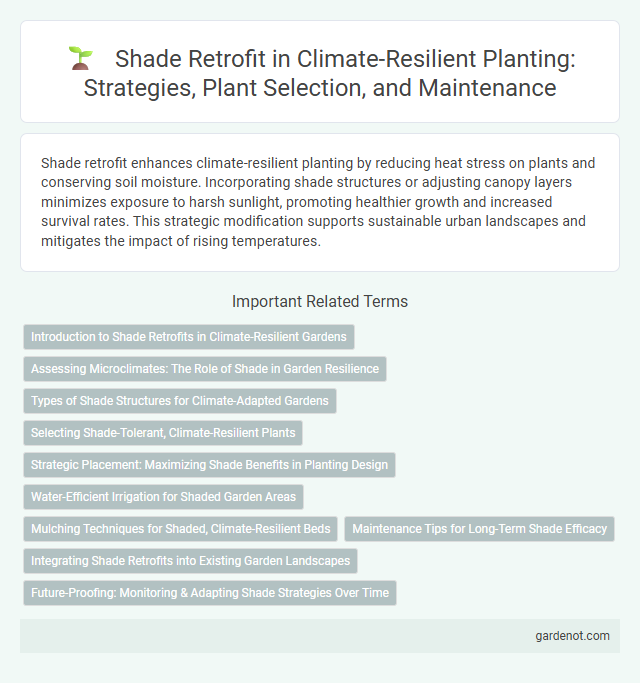Shade retrofit enhances climate-resilient planting by reducing heat stress on plants and conserving soil moisture. Incorporating shade structures or adjusting canopy layers minimizes exposure to harsh sunlight, promoting healthier growth and increased survival rates. This strategic modification supports sustainable urban landscapes and mitigates the impact of rising temperatures.
Introduction to Shade Retrofits in Climate-Resilient Gardens
Shade retrofits in climate-resilient gardens enhance plant survival by reducing heat stress and conserving soil moisture through strategic shading structures. Utilizing drought-tolerant native species combined with engineered shade installations improves microclimate conditions and supports biodiversity under extreme weather. These adaptations increase garden resilience to temperature fluctuations and prolonged dry periods, promoting sustainable urban landscapes.
Assessing Microclimates: The Role of Shade in Garden Resilience
Assessing microclimates is crucial for climate-resilient planting, as shade significantly influences garden resilience by moderating temperature extremes and reducing water evaporation. Strategic shade retrofit enhances plant health by creating cooler, more stable environments that protect sensitive species from heat stress and drought. Integrating native shade trees and engineered structures optimizes microclimate conditions, promoting biodiversity and long-term sustainability.
Types of Shade Structures for Climate-Adapted Gardens
Shade retrofitting involves integrating various types of shade structures such as pergolas, shade sails, and retractable awnings to enhance climate resilience in gardens. These structures provide vital protection against excessive sun exposure, reducing heat stress on plants and conserving soil moisture. Selecting materials like UV-resistant fabrics and sustainably sourced wood ensures durability and environmental compatibility for long-term garden adaptation.
Selecting Shade-Tolerant, Climate-Resilient Plants
Selecting shade-tolerant, climate-resilient plants enhances the success of shade retrofit projects by ensuring vegetation thrives under limited sunlight and variable weather conditions. Species such as ferns, hostas, and certain native grasses exhibit strong adaptability to shade while requiring less water, contributing to sustainable landscaping practices. Integrating drought-resistant and pest-tolerant varieties further improves long-term plant survival and ecosystem stability in climate-stressed environments.
Strategic Placement: Maximizing Shade Benefits in Planting Design
Strategic placement of shade trees enhances microclimate regulation by reducing soil temperatures and conserving moisture, critical for climate-resilient planting. Positioning trees to maximize shade during peak sunlight hours minimizes evapotranspiration, supporting plant health and reducing irrigation needs. Integrating shade retrofit techniques in urban and agricultural landscapes optimizes energy efficiency and mitigates heat stress impacts on crops and ecosystems.
Water-Efficient Irrigation for Shaded Garden Areas
Shade retrofit projects in gardens enhance water sustainability by implementing water-efficient irrigation systems such as drip irrigation and subsurface emitters specifically designed for shaded areas. These systems reduce evaporation and runoff, optimizing moisture delivery directly to plant roots in low-light conditions, crucial for climate resilience. Incorporating soil moisture sensors further refines irrigation schedules, ensuring precise water usage and promoting healthy plant growth under shade.
Mulching Techniques for Shaded, Climate-Resilient Beds
Mulching techniques for shaded, climate-resilient beds enhance soil moisture retention and reduce temperature fluctuations, crucial for adapting to climate variability. Organic mulches such as wood chips, leaf litter, and compost improve soil health by increasing microbial activity and nutrient availability beneath shade trees. These practices support root protection and suppress weed growth, fostering robust plant development in climate-resilient landscaping.
Maintenance Tips for Long-Term Shade Efficacy
Regular pruning and inspection of shade structures prevent deterioration and maintain optimal canopy density, ensuring effective solar protection. Applying protective coatings and treating wooden or metal components against weather-related wear extend the lifespan of shade retrofits. Implementing routine cleaning and promptly repairing any damage preserves material integrity and maximizes long-term shade efficacy in climate-resilient planting systems.
Integrating Shade Retrofits into Existing Garden Landscapes
Integrating shade retrofits into existing garden landscapes enhances climate resilience by reducing heat stress on plants and conserving soil moisture. Using drought-tolerant shade trees and strategically placing shade structures optimizes microclimate conditions and supports biodiversity. These retrofit solutions contribute significantly to sustainable urban gardening by mitigating temperature extremes and improving plant health.
Future-Proofing: Monitoring & Adapting Shade Strategies Over Time
Implementing climate-resilient planting requires continuous monitoring of shade retrofit systems to ensure they adapt to changing environmental conditions and extreme weather patterns. Future-proofing these strategies involves integrating real-time data analytics and sensor technology to optimize canopy density and placement for maximum thermal regulation. Adaptive management practices enhance plant health and urban microclimates, reducing heat stress and improving long-term sustainability in vulnerable ecosystems.
Shade retrofit Infographic

 gardenot.com
gardenot.com